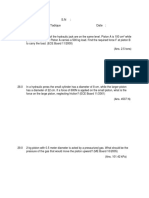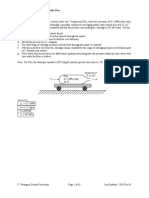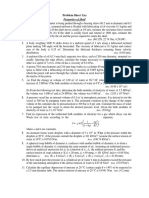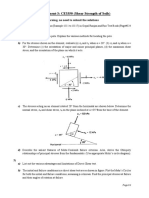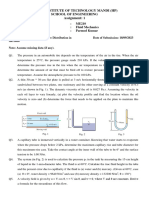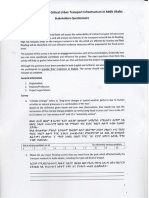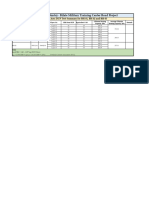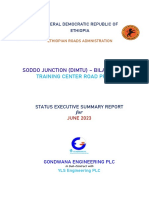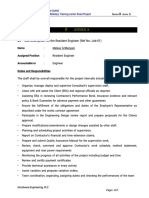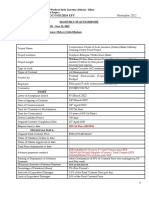Exercise Problems
Exercise Problems
Uploaded by
AshebirCopyright:
Available Formats
Exercise Problems
Exercise Problems
Uploaded by
AshebirOriginal Title
Copyright
Available Formats
Share this document
Did you find this document useful?
Is this content inappropriate?
Copyright:
Available Formats
Exercise Problems
Exercise Problems
Uploaded by
AshebirCopyright:
Available Formats
CENG 6207: Advanced Soil Mechanics
Assignment Problems
1. An isotropic compression test was conducted on a clay soil specimen that had a volume of 78 cm3 in a
triaxial cell. The test was ended while it has a moisture content of 0.35 under a cell pressure of 80 kPa.
The results of the test are given in the following Table. Determine the soil parameters.
Cell pressure (kPa) Volume of
expelled water cc
30 0
80 6.8
220 14
800 24
240 21
80 18
2. The above sample was isotropically normally consolidated to a mean effective stress of 300 kN/m2 and
the soil specific volume parameter that defines the position of the CSL with slope of 0.90 is 3.23. If the
sample is subjected to a standard undrained triaxial compression test, calculate the deviatoric stress, the
mean effective stress and specific volume at failure. Redo the problem if the test is drained at initial
specific volume as obtained in the undrained test.
3. Two specimens, A and B, of a clay were each isotropically consolidated under a cell pressure of 275 kPa
and then unloaded isotropically to a mean effective stress of 150 kPa. CD and CU tests are carried out on
A and B respectively. The cell pressure is held constant 150 kPa and the soil parameters are =0.321,
=0.045, and initial void ratio is 1.21 and friction angle is 23o. N=3.32. Estimate, for each specimen,
a) the yield stresses interms of the p-q and principal normal stress representations,
b) the corresponding failure stresses for the problem in a,
c) the excess pore water pressure at yield and failure.
4. Two specimens from a soil characterized by M=1.05, =0.32, =0.045, and N=3.33 are isotropicaly
normally consolidated in a triaxial apparatus to p’=200 kPa with no porewater pressure generation. After
this each is subjected to a loading test in which the total axial stress is increased to 240 kPa with no
change in the radial stress. If sample 1 is loaded drained and sample 2 is loaded undrained, estimate the
volumetric and shear strains and the change in the pore pressure for each sample using Cam-clay theory.
You might also like
- SampleqsDocument8 pagesSampleqstommtommNo ratings yet
- Supervision ManualDocument89 pagesSupervision ManualAshebir100% (1)
- Mercury Grand Marquis Owners Manual 1998Document152 pagesMercury Grand Marquis Owners Manual 1998Masood Alam FarooquiNo ratings yet
- Shear Strength of Soil Solved ProblemsDocument13 pagesShear Strength of Soil Solved ProblemsGino BulataoNo ratings yet
- Scribd Download - Com Fluid Mechanics Lecture 2 Problems and AnswersDocument6 pagesScribd Download - Com Fluid Mechanics Lecture 2 Problems and AnswersRomil ShahNo ratings yet
- Consolidated-Undrained Tri-Axial Test (Cu - Test) : Problem 1Document14 pagesConsolidated-Undrained Tri-Axial Test (Cu - Test) : Problem 1Jemuel FloresNo ratings yet
- SP 1 (Fluid Properties)Document14 pagesSP 1 (Fluid Properties)Jap Ibe50% (2)
- Tutorial Sheet - 5 - CE 1403 Geotechnical Engineering - 230426 - 092421Document3 pagesTutorial Sheet - 5 - CE 1403 Geotechnical Engineering - 230426 - 092421imamadnan69No ratings yet
- Final Exam-Advanced Soil MechanicsDocument2 pagesFinal Exam-Advanced Soil MechanicsBikaZee100% (1)
- Assignment 01Document3 pagesAssignment 01sahilbarbade.ee101No ratings yet
- SKMM 2413 - Test 1 - 20172018 - Sem 1Document5 pagesSKMM 2413 - Test 1 - 20172018 - Sem 1Abdulrahman DesoukyNo ratings yet
- Fluid Mechanics Lecture 2 Problems and AnswersDocument5 pagesFluid Mechanics Lecture 2 Problems and AnswersAlex LakeNo ratings yet
- CompressibleFlow PracticeProblemsDocument42 pagesCompressibleFlow PracticeProblemsmavilla10100% (1)
- University of Nairobi Department of Civil and Construction EngineeringDocument9 pagesUniversity of Nairobi Department of Civil and Construction EngineeringLovian MagandaNo ratings yet
- Thermo 27 45 1 29Document18 pagesThermo 27 45 1 29Danerys Targaryan0% (1)
- Test 1 SUMMER 2019 MECH 2311Document3 pagesTest 1 SUMMER 2019 MECH 2311Jordy TorresNo ratings yet
- CompressibleFlow PracticeProblemsDocument42 pagesCompressibleFlow PracticeProblemsGautam KadianNo ratings yet
- Module 7 - Tutorial 1 (Shear Strength) (OK)Document2 pagesModule 7 - Tutorial 1 (Shear Strength) (OK)Asfin HaqueNo ratings yet
- AssignmentDocument2 pagesAssignmentBogale SenayNo ratings yet
- FM-Assignment 1680339329419Document4 pagesFM-Assignment 1680339329419Hasan javedNo ratings yet
- Sheet 01 20-21 Properties of Fluid RevDocument2 pagesSheet 01 20-21 Properties of Fluid RevBibaswan MukherjeeNo ratings yet
- ME 303 Study Set PDFDocument44 pagesME 303 Study Set PDFFajar RumantoNo ratings yet
- Fluid MechanicsDocument2 pagesFluid MechanicsLokendra Singh JhalaNo ratings yet
- Adama Science and Technology University School of Civil Engineering and Architecture Department of Civil EngineeringDocument10 pagesAdama Science and Technology University School of Civil Engineering and Architecture Department of Civil EngineeringAmanuel TkNo ratings yet
- HW2 SolutionDocument6 pagesHW2 SolutionHamka HidayahNo ratings yet
- Assignment 1 (Chapter 1: Introduction)Document10 pagesAssignment 1 (Chapter 1: Introduction)Ragh AhmedNo ratings yet
- Assignment-3: CE3350 (Shear Strength of Soils) : Due Date: For Self-Learning, No Need To Submit The SolutionsDocument6 pagesAssignment-3: CE3350 (Shear Strength of Soils) : Due Date: For Self-Learning, No Need To Submit The SolutionsAddandi AshrithNo ratings yet
- 2022 SAMPLE TEST 1 Set ADocument7 pages2022 SAMPLE TEST 1 Set ANizNo ratings yet
- Assignment 1 PDFDocument8 pagesAssignment 1 PDFOmar Adel MohamedNo ratings yet
- Assignment 1Document4 pagesAssignment 1vaibhavomega.123No ratings yet
- Tutorial 2 (Fluid Properties) - Fluid MechanicsDocument3 pagesTutorial 2 (Fluid Properties) - Fluid Mechanicsain nizamNo ratings yet
- CE6101 Problem Sheet 4Document1 pageCE6101 Problem Sheet 4HT BinhNo ratings yet
- Hydraulics Individual Assignment IDocument5 pagesHydraulics Individual Assignment Ikibrom fishaNo ratings yet
- Assignment# 1: SolutionDocument8 pagesAssignment# 1: SolutionpersistentengineerNo ratings yet
- Lec 3A Sample Problem B Prop of FluidsDocument2 pagesLec 3A Sample Problem B Prop of FluidsAuvrey Mae TagarianNo ratings yet
- Tutorial ECG243 4B ConsolidationDocument7 pagesTutorial ECG243 4B Consolidationpatrick batangNo ratings yet
- CVG 3106 Chp1 ReviewDocument31 pagesCVG 3106 Chp1 ReviewOusama KadriNo ratings yet
- Chapter 4Document10 pagesChapter 4Kalpesh JadhavNo ratings yet
- Validation Soft Soil Creep Model Undrained Triaxial Creep Behaviour Haney Clay 2016Document6 pagesValidation Soft Soil Creep Model Undrained Triaxial Creep Behaviour Haney Clay 2016boris1516No ratings yet
- Tutorial 2Document4 pagesTutorial 2Malindu WickramasingheNo ratings yet
- Practice Problems-GeoDocument9 pagesPractice Problems-Geodeyanmarte2No ratings yet
- Assignmet Shear StrengthDocument2 pagesAssignmet Shear StrengthHadia EmanNo ratings yet
- Ri Preboard - April - 2023 - Hge PDFDocument6 pagesRi Preboard - April - 2023 - Hge PDFRichelle Faye VillaverdeNo ratings yet
- Consolidated Drained Tri AxialDocument15 pagesConsolidated Drained Tri AxialJemuel FloresNo ratings yet
- Tutorial MED205Document4 pagesTutorial MED205Anonymous V4jDKjUR6No ratings yet
- Assignment ProblemsDocument2 pagesAssignment ProblemsVenkitaraj K PNo ratings yet
- Practice Problems Set 9Document2 pagesPractice Problems Set 9Ashutosh BhardwajNo ratings yet
- Flow in Pipes: Mechanical Engineering DepartmentDocument3 pagesFlow in Pipes: Mechanical Engineering DepartmentKeroles SabryNo ratings yet
- HW2 SolutionDocument6 pagesHW2 SolutionHamzaJehadNo ratings yet
- CE602 MockboardQuiz2Document8 pagesCE602 MockboardQuiz2Najib A. CasanNo ratings yet
- Thapar University, Patiala Department of Chemical EngineeringDocument2 pagesThapar University, Patiala Department of Chemical EngineeringsahibjotNo ratings yet
- ME3122E - Tutorial Solution 3Document8 pagesME3122E - Tutorial Solution 3LinShaodun100% (3)
- Azeiteiro 220.00Document9 pagesAzeiteiro 220.00shachen2014No ratings yet
- Problemas Mec Fluidos MoyDocument6 pagesProblemas Mec Fluidos MoyKrlitos Alberto Soria OrnelasNo ratings yet
- FM-Assignment-1 1658822458292Document4 pagesFM-Assignment-1 1658822458292The AnonymousNo ratings yet
- CHE311 Practice Problems 2012Document9 pagesCHE311 Practice Problems 2012Albert HuynhNo ratings yet
- Unit Operation Filtration ExampleDocument3 pagesUnit Operation Filtration ExamplePhiak KimNo ratings yet
- 化熱chapt3Document5 pages化熱chapt3卓冠妤No ratings yet
- Casading ME 3Document11 pagesCasading ME 3Amandeep SinghNo ratings yet
- Reviews in Computational ChemistryFrom EverandReviews in Computational ChemistryAbby L. ParrillNo ratings yet
- Analytical Modeling of Solute Transport in Groundwater: Using Models to Understand the Effect of Natural Processes on Contaminant Fate and TransportFrom EverandAnalytical Modeling of Solute Transport in Groundwater: Using Models to Understand the Effect of Natural Processes on Contaminant Fate and TransportNo ratings yet
- Summary of Sub Grade Test Result.... 2Document8 pagesSummary of Sub Grade Test Result.... 2AshebirNo ratings yet
- Summary of Subgrade After Excavation Material Test Result and Approval Record SheetDocument13 pagesSummary of Subgrade After Excavation Material Test Result and Approval Record SheetAshebirNo ratings yet
- Disterbud Sample SummaryDocument2 pagesDisterbud Sample SummaryAshebirNo ratings yet
- Classification Test - BH-1 (Depth 2m)Document2 pagesClassification Test - BH-1 (Depth 2m)AshebirNo ratings yet
- Stakeholders Sruvey Questionnaire - in AmharicDocument5 pagesStakeholders Sruvey Questionnaire - in AmharicAshebirNo ratings yet
- Title 01 Proposal - SeidDocument1 pageTitle 01 Proposal - SeidAshebirNo ratings yet
- Corridor 5TP001 005Document35 pagesCorridor 5TP001 005AshebirNo ratings yet
- Final Design Review Report (Sept 2023)Document195 pagesFinal Design Review Report (Sept 2023)Ashebir100% (1)
- DCP Test Result Summary For BH-01, 02 & 03Document8 pagesDCP Test Result Summary For BH-01, 02 & 03AshebirNo ratings yet
- Status Report (June 2023)Document13 pagesStatus Report (June 2023)AshebirNo ratings yet
- On Job Training in Branch Banking OperationDocument7 pagesOn Job Training in Branch Banking OperationAshebir100% (1)
- Executive ReportDocument8 pagesExecutive ReportAshebirNo ratings yet
- Ashebir Tajebe - Identification of Collapsibility Potential of Problematic Soil Along Shashemene - Aje Road Corridor, Ambure SiteDocument165 pagesAshebir Tajebe - Identification of Collapsibility Potential of Problematic Soil Along Shashemene - Aje Road Corridor, Ambure SiteAshebirNo ratings yet
- CV (Ashebir Tajebe)Document7 pagesCV (Ashebir Tajebe)AshebirNo ratings yet
- Quarter ReportDocument16 pagesQuarter ReportAshebirNo ratings yet
- Tripartite ReportDocument15 pagesTripartite ReportAshebirNo ratings yet
- March FDT SummaryDocument7 pagesMarch FDT SummaryAshebirNo ratings yet
- Standard FormsDocument71 pagesStandard FormsAshebirNo ratings yet
- Dimtu - Blate Military Borro Pit (W-W' 0+700LHSDocument46 pagesDimtu - Blate Military Borro Pit (W-W' 0+700LHSAshebirNo ratings yet
- TCS Design SummaryDocument8 pagesTCS Design SummaryAshebirNo ratings yet
- Dimtu - Blate Military Borro Pit (BP BCC +420RHSDocument47 pagesDimtu - Blate Military Borro Pit (BP BCC +420RHSAshebirNo ratings yet
- DBRP Job DescriptionsDocument23 pagesDBRP Job DescriptionsAshebirNo ratings yet
- Surveying Monthly Report MAY 2023.Document3 pagesSurveying Monthly Report MAY 2023.AshebirNo ratings yet
- Quality Assurance ManualDocument114 pagesQuality Assurance ManualAshebirNo ratings yet
- Status of Auxiliary SiteDocument1 pageStatus of Auxiliary SiteAshebirNo ratings yet
- Ethiopian Roads Administration: Dimtu TownDocument47 pagesEthiopian Roads Administration: Dimtu TownAshebirNo ratings yet
- Status Report For The Month of Nov 2022Document11 pagesStatus Report For The Month of Nov 2022AshebirNo ratings yet
- To: Raycon Construction Addis Ababa Subject: Application For The Posted Job - ' Project Manager 'Document1 pageTo: Raycon Construction Addis Ababa Subject: Application For The Posted Job - ' Project Manager 'AshebirNo ratings yet
- HEALTH - AND - SAFETY - MANAGMENT - PLAN SodoDocument31 pagesHEALTH - AND - SAFETY - MANAGMENT - PLAN SodoAshebir100% (1)
- 7414N Hex 1-Input Invert Gate,.Document4 pages7414N Hex 1-Input Invert Gate,.patricio.diazNo ratings yet
- HSE Information Sheet: Industrial Radiography - Managing Radiation RisksDocument5 pagesHSE Information Sheet: Industrial Radiography - Managing Radiation RiskserskdNo ratings yet
- Crack Width Calculation For ColumnDocument3 pagesCrack Width Calculation For ColumnMohammad Kasim0% (1)
- Block Board From Melia DubiaDocument5 pagesBlock Board From Melia DubiaPremier PublishersNo ratings yet
- TRDocument8 pagesTRChandan Kumar SinghNo ratings yet
- Estimate Lesson 3 ConcreteDocument21 pagesEstimate Lesson 3 ConcreteBCXC LLAMNo ratings yet
- REtrofit 12 To 134aDocument18 pagesREtrofit 12 To 134aAurelio Jr TambigaNo ratings yet
- 66a515a2e5127a3acc13b1f9 - ## - Electromagnetic Induction - JEE Main & Advanced Practice Sheet - Lakshya JEE 2025Document48 pages66a515a2e5127a3acc13b1f9 - ## - Electromagnetic Induction - JEE Main & Advanced Practice Sheet - Lakshya JEE 2025nikhilkumar09041No ratings yet
- Create A Family Emergency PlanDocument8 pagesCreate A Family Emergency PlanAnonymous X3NoCINo ratings yet
- Catalog Sinteso Incendiu PDFDocument222 pagesCatalog Sinteso Incendiu PDFRadu OprisoniNo ratings yet
- Exp 6Document17 pagesExp 6Vivek ShahNo ratings yet
- Design and Development of Compound Lever Handle For Hand PumpDocument4 pagesDesign and Development of Compound Lever Handle For Hand PumpyadneshdNo ratings yet
- 2012 Harley Davidson Iron 883 66719 PDFDocument149 pages2012 Harley Davidson Iron 883 66719 PDFLucas Vieira LimaNo ratings yet
- Dunlop Technical Information Chart PDFDocument1 pageDunlop Technical Information Chart PDFTrung QuangNo ratings yet
- FI-2 - Ecolab ManualDocument3 pagesFI-2 - Ecolab ManualNit TasanaNo ratings yet
- C4 Mask NBC Operators Manual EnglishDocument36 pagesC4 Mask NBC Operators Manual EnglishwgmdszblczcNo ratings yet
- MANUAL CaptaVisionDocument56 pagesMANUAL CaptaVisionNelson CruzNo ratings yet
- Eurovent - 4 - 22 - 2015 PDFDocument8 pagesEurovent - 4 - 22 - 2015 PDFPeter_Phee_341No ratings yet
- TeraData Dual LoadDocument16 pagesTeraData Dual LoadAnilkumar DakiNo ratings yet
- Steel & InternationalDocument75 pagesSteel & InternationalSara LopezNo ratings yet
- Corrosion Control or Corrosion Management?Document6 pagesCorrosion Control or Corrosion Management?PrasadNo ratings yet
- Control de Dirección 230-1024 D5G RKG01398 PDFDocument3 pagesControl de Dirección 230-1024 D5G RKG01398 PDFJabith CastilloNo ratings yet
- Week 9 ExampleDocument67 pagesWeek 9 ExampleCan MunganNo ratings yet
- Cpphtp7 01 IMDocument7 pagesCpphtp7 01 IMZach FergerNo ratings yet
- Ballast and Firefight SystemDocument10 pagesBallast and Firefight SystemJasper AbrantesNo ratings yet
- CH 08Document8 pagesCH 08Ingi Abdel Aziz Srag0% (1)
- Tuttnauer - Intl - 69 - Medical - CAT2007 - Ver 1.4Document9 pagesTuttnauer - Intl - 69 - Medical - CAT2007 - Ver 1.4Leonel Losada CardozoNo ratings yet
- Principles of MEMS TransducersDocument19 pagesPrinciples of MEMS TransducersTechdevtodo DevtodoNo ratings yet
- Subject - Machine Design - : Topic - Spur GearDocument10 pagesSubject - Machine Design - : Topic - Spur GearRohit GhulanavarNo ratings yet














